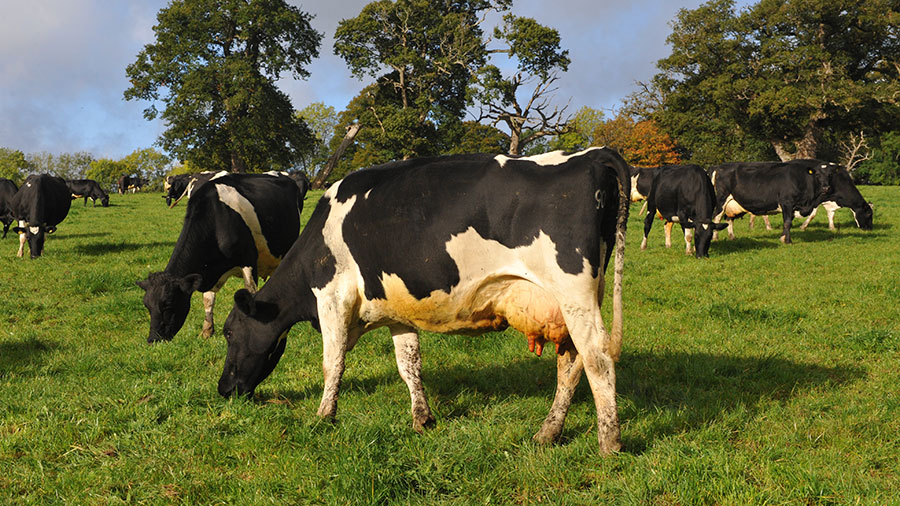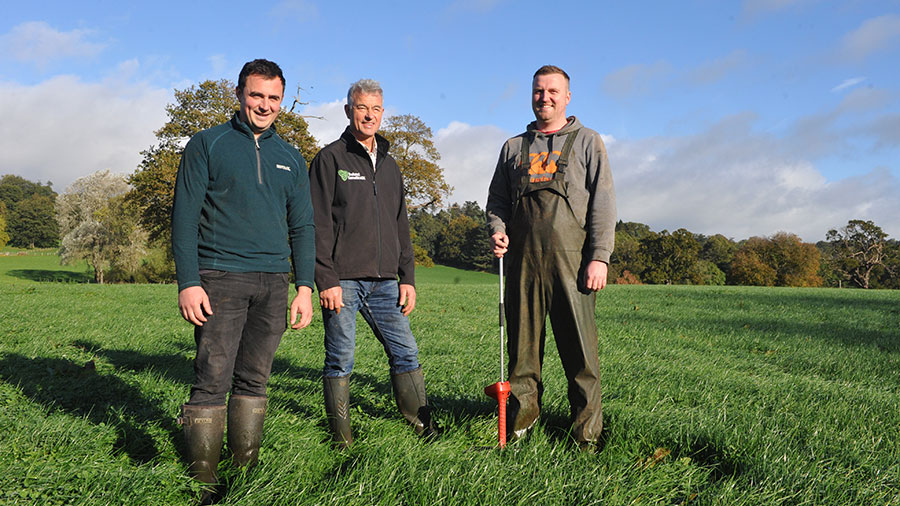How a dairy farmer manages challenging grazing conditions
 © David Jones
© David Jones Dairy farmer Andrew Giles is growing 13t dry matter (DM)/ha of grass a year, on average, despite only receiving 860mm of rain annually at Maesllwch Home Farm, near Three Cocks, Wales.
Mr Giles and his team are producing 5,795 litres a cow a year of milk sold from a concentrate input of just 800kg a cow a year.
This is being achieved by regularly measuring and recording grass growth and identifying pinch points in the growing season.
See also: 8 steps to get started with regen grassland management
The grass measuring and data inputting are done every Monday by herd manager John Thomas; the data is processed using AgriNet to give an accurate picture of grass covers and growth.
That data is discussed at a team meeting between Mr Giles, Mr Thomas, farm foreman, Tom Williams, and assistant herd manager, Tom Freeman.
Mr Giles says: “The minute growth rate drops below what we would deem to be average for that time of year, especially if there is no rain in the forecast, we start to put [a plan] in place.”

Tom Williams, Andrew Giles and John Thomas © David Jones
Strategies to cope with dry weather
The first action is to extend the grazing round length. If a dry spell is forecast, they would initially increase concentrate feeding and, if needs be, feed silage in the paddock on top of a fresh break to reduce grass demand.
In this situation, all paddocks are brought into the rotation and silage cutting is delayed.
“We try to avoid cutting large areas of silage at once as this can create a self-induced drought,’’ Mr Giles explains.
Purchased grain is milled by a mobile mill and mixed with rapemeal and minerals. In 2020, this worked out at an average price of £160/t.
This combination of steps is important because it can make a massive difference to the effect that drought has on grass availability and milk yield.
Farm facts
- 550 spring-calving New Zealand Friesian cows
- Producing 5,795 litres (505kg milk solids) sold at 4.72% butterfat and 3.71% protein
- Loam soils
- Milk supplied to Arla
- 20ha (50 acres) of maize and 20ha (50 acres) of silage grown on offlying land
- Youngstock reared on a 160ha second farm
- Grass growth is shared with the Farming Connect Welsh Pasture Project
Grazing strategies
Mr Giles maintains a higher average farm cover (AFC) than most dairy grazing systems, at 2,300kg DM/ha (compared with an average of 2,000kg DM/ha on farms within the Welsh Pasture Project – see “Welsh Pasture Project” for more details). This helps retain more moisture in the soil.
An autumn rotation planner is key to hitting good opening covers and reducing reliance on purchased fertiliser requirements in the spring. In fact, 2021 has shown just how important a planner is.
“We started off with extremely good August [grass] growth, at a time when we would normally be putting in silage to build covers. But we got to early September and there hadn’t been rain for a while. This meant our projected 60kg DM/ha growth dropped by about 30kg DM, and that influenced the autumn planner.”
Extra silage was fed to manage this. “If you can see a grass shortage coming, by measuring and having that data, you can manage the situation,’’ says Mr Giles.
He adds: “It would be really difficult to manage autumn grazing and to be confident there would be enough grass in the spring if we didn’t use a rotation planner.”
Closing for the winter
Mr Giles aims for relatively high closing covers of 2,350-2,400kg DM/ha because, as well as being dry, the farm experiences cold winter conditions. Cows were housed by day on 16 October and will be fully housed on 23 November.
“High covers will overwinter well provided you have a good cleanout in the autumn. We then have fresh, green swards, not dead material,’’ says Mr Giles.
“When we first moved to Glasbury from Pembrokeshire, we were using the closing cover figures we would have applied there. But because the conditions are very different here, we found we didn’t have enough grass in the spring, so we needed to fine-tune our feed budgeting plan,” says Mr Giles.
In the spring, the first paddocks to be grazed will have opening covers of 3,500kg DM/ha, but the average farm cover is a minimum of 2,200kg DM/ha. Turnout by day happens once 30 animals have calved. Magic day – the day grass supply equals demand – is typically hit in the first week of April.
Reseeding
About 10% of the farm is reseeded annually with customised Aber seed mixes that are based on grazing trial work.
“I was once told that it takes five to 10 years to change cow genetics but just a year to alter grass genetics, and that can definitely be the case through reseeding,” explains Mr Giles.
The whole team is fully focused on how important grass is to the business, he says, urging other farmers to adopt that mindset.
“Farmers need to get it into their heads that weekly grass measuring needs to be done without fail.”
At a time when input prices are extremely volatile, grass-based milk production is very resilient, he adds.
“Escalating feed prices have less effect on the bottom line when you are feeding a few hundred kilos, and short housing periods require less silage.
“Our challenge now is to become less reliant on manufactured nitrogen.’’
To achieve this, he is currently building a new slurry lagoon to comply with the all-Wales nitrogen vulnerable zone regulation. This will enable slurry to be used more efficiently.
Mr Giles is also considering using more foliar feed to reduce fertiliser and says clover will play a greater role in grassland to help fix nitrogen.
Welsh Pasture Project
Data from the Welsh Pasture Project has shown that 2021 has been a challenging year for managing grass.
As part of the project, 49 dairy, beef and sheep farmers, farming a range of different land types and systems across Wales, have been measuring their pasture regularly since September 2020.
Dairy farmers measure on a weekly basis and beef and sheep farmers every two weeks.
The cold and slow start to the grazing season led to grass shortages in April and May, says Sarah Morgan of Precision Grazing, who collates the project data on behalf of Farming Connect.
This was followed by a surge in growth rates in June, when many farms struggled to maintain quality.
“Localised rainfall during the summer months means there has been a large variation in grass growth rates, with some farms carrying a surplus all summer and others having to buffer feed during the dry period,” says Ms Morgan.
However, late summer brought rainfall and good temperatures for most, allowing grass covers to build, setting farmers up in a good position for the autumn grazing period. Grass growth on some farms had peaked at 120kg DM/ha but on others, it was 80kg DM/ha.
Sixteen farms have been taking monthly fresh pasture samples for near infrared analysis. Sampling showed that average quality had not dropped below 11MJ of metabolisable energy or 20% protein, giving many farmers the confidence to remove or reduce concentrate use.
The data, says Ms Morgan, has been useful in informing decision-making on other farms in each of the regions.
“It is being used for a range of things, from determining stocking rates in line with growth rates in the region, to making weekly management decisions.”
